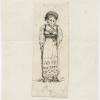‘Latin Maiden of Tešanj’
Commentary
Page featuring an engraving (made after a drawing by Arthur Evans), captioned ‘Latin Maiden of Tešanj’, published in Arthur J. Evans, Through Bosnia and the Herzegóvina on Foot during the Insurrection, August and September 1875 (London, 1876), p.120.
Artist: Unidentified engraver, after an original drawing [1941.8.170] by Arthur John Evans
Date of publication: 1876
Continent: Europe
Geographical area: Southern Europe
Country: Bosnia and Herzegovina
Region/Place: Tešanj
Cultural group: European Bosnian
Format: Woodcut engraving
Page size: 234 x 141 mm
Acquisition: Henry Balfour. Bequeathed February 1939
***
Research notes: It has been identified by Philip Grover that this woodcut engraving by an unnamed artist was based on an original drawing [1941.8.170] by Arthur John Evans, being the portrait of a Catholic inhabitant of Tešanj. It was published in Evans’ account of his journey, Through Bosnia and the Herzegóvina on Foot during the Insurrection, August and September 1875 (London, 1876), p.120, printed with the caption ‘Latin Maiden of Tešanj’. Evans recorded in the volume: ‘While trying to make my way to the other side of the valley I found myself hemmed in by a variety of fences, which I was forced to surmount, and run the gauntlet though private orchards, with whose owners I happily avoided an encounter, and finally emerged with a whole skin on the Christian quarter, which lies east of the castle. The inhabitants here belonged to the Latin Church; but though the Roman Catholic priesthood in Bosnia leans toward Croatia, and shrinks from Serbia with more horror than from Stamboul, yet these Latin women of Tešanj betrayed, perhaps unconsciously, their sisterhood with the heretics of Drina. They were not coiffed Croat fashion, in a kerchief, like the peasants we had seen in the Bosnian Possavina, but their hair was plaited round a fez, à la belle Serbe, with flowers stuck in coquettishly on one side, and drooping gracefully about the ear. They displayed, too, the Serbian partiality for purple, and a maiden with a scarf crossed over the bosom recalled the peasant girls around Belgrade. The rest of their dress - the double girdle, the twin aprons, the tunics with expanding sleeves - may be described as South Sclavonic. The men, though surmounted with turbans, differed usually in place of the gorgeous vest and jacket, and short flowing white trowsers instead of indigo bags. Those Christian men, however, who were more well to do, and inhabited the mercantile part of the town, were, like our landlord, in complete Turkish costume’: Through Bosnia and the Herzegóvina on Foot, pp.119–120.

